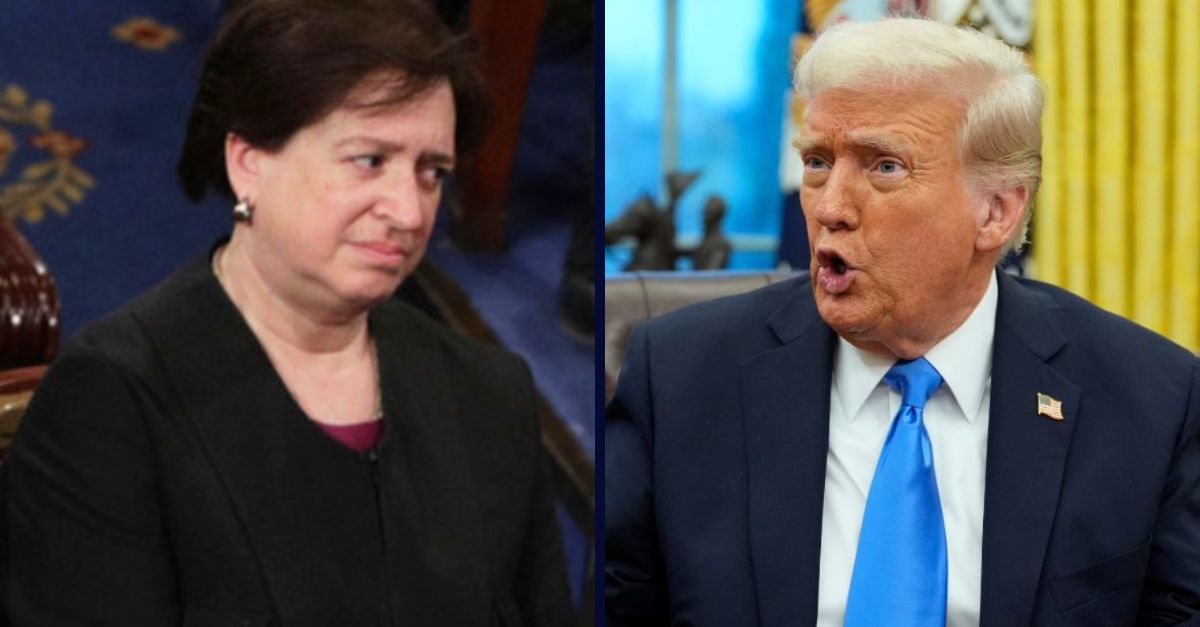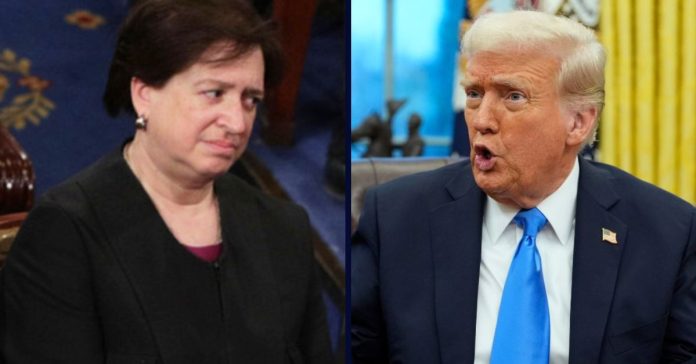
Left: Justice Elena Kagan listening to President Donald Trump’s address before a joint session of congress on February 28, 2017 (Photo by Alex Wong/Getty Images). Right: President Donald Trump speaks with reporters in the Oval Office at the White House, Tuesday, Feb. 11, 2025, in Washington. (AP Photo/Alex Brandon).
The U.S. Supreme Court late Wednesday afternoon gave the Trump administration the go-ahead to fire three Biden-era members of the Consumer Product Safety Commission (CPSC).
Acting on an application for a stay, a majority of justices voted to overturn a permanent injunction issued in mid-June by U.S. District Judge Matthew J. Maddox, a Joe Biden appointee. That injunction barred the government from issuing the firings, granted the plaintiffs access to agency resources, and ordered the government to provide back pay and benefits to the plaintiffs and their staff.
In late June, the Trump administration took its case to the U.S. Court of Appeals for the Fourth Circuit, requesting emergency relief in the form of an immediate administrative stay, as well as a broader stay pending appeal of the underlying case on the merits.
The appellate court, however, was not receptive to the government’s request and unanimously nixed it earlier this month.
But fortune often favors the government on the high court’s emergency – or shadow – docket. Now, the Trump administration is free to, once again, fire the disputed political appointees.
Love true crime? Sign up for our newsletter, The Law&Crime Docket, to get the latest real-life crime stories delivered right to your inbox.
The opinion – which appeared to be 6-3; the exact vote was not published – made a point to reference an earlier, similar case from the same term. In that opinion, stylized as Trump v. Wilcox, the justices allowed the Trump administration to oust two Joe Biden-appointed members of independent federal labor agencies.
“The stay we issued in Wilcox reflected ‘our judgment that the Government faces greater risk of harm from an order allowing a removed officer to continue exercising the executive power than a wrongfully removed officer faces from being unable to perform her statutory duty,'” the Wednesday opinion reads. “The same is true on the facts presented here, where the Consumer Product Safety Commission exercises executive power in a similar manner as the National Labor Relations Board, and the case does not otherwise differ from Wilcox in any pertinent respect.”
In early May, President Donald Trump, by way of individuals “purporting to speak” on his behalf, fired the trio by email.
The terse emails offered no criticism or justification whatsoever – simply stating they were “terminated effective immediately.”
The crux of the lawsuit is a dispute over whether Trump had authority to fire them at all, since they had yet to serve out the remainder of their fixed terms “after having been confirmed by the Senate.”
The plaintiffs – Mary Boyle, Alexander Hoehn-Saric, and Richard Trumka Jr. – claimed their firings and subsequent efforts to fire their staffers were unlawful and in violation of the Consumer Product Safety Act (CPSA), the originating statute that created the CPSC. The statute says CPSC members can only be removed by the president “for neglect of duty or malfeasance in office but for no other cause.”
This language – and similar such language – is viewed by the plaintiffs and their advocates as intentional verbiage intended to keep “quasi judicial and quasi legislative” agencies largely insulated from the whims of the president.
In last month’s failed appeal to stay the injunction, as well as the successful emergency application, the government argued that such so-called “for-cause” removal language is unconstitutional.
The justices have yet to rule on the merits – and made a point to clarify this in the opinion – of any for-cause statutory protections in the context of the current political battles. Nor has the court even taken up the question on the merits.
In a concurrence, Justice Brett Kavanaugh expresses a certain level of discomfort with this state of affairs.
“When an emergency application turns on whether this Court will narrow or overrule a precedent, and there is at least a fair prospect (not certainty, but at least some reasonable prospect) that we will do so, the better practice often may be to both grant a stay and grant certiorari before judgment,” the concurrence reads. “In those unusual circumstances, if we grant a stay but do not also grant certiorari before judgment, we may leave the lower courts and affected parties with extended uncertainty and confusion about the status of the precedent in question.”
Kavanaugh goes on to say he would have voted to grant certiorari in the case because there is not really any reason for lower courts to deal with the issue since they cannot “alter or overrule” the Supreme Court’s precedents.
In dissent, Justice Elena Kagan – joined by Justice Sonia Sotomayor and Justice Ketanji Brown Jackson – sharply bemoaned the latest emergency stay translating into a political win for the 45th and 47th president.
“Once again, this Court uses its emergency docket to destroy the independence of an independent agency, as established by Congress,” the dissent complained.
After briefly going through the congressional design of the CPSC as the lower courts viewed it, the dissent staked out familiar territory by referring to an instrumental 1935 Supreme Court case regarding limitations on the president’s ability to fire appointed officials at will.
The case in question, Humphrey’s Executor v. U.S., has been cited by numerous district and appellate courts to protect political appointees from Trump’s chopping block. The dissent accused the majority of overruling the case without saying so.
Kagan then offers a broadside attack on her GOP-appointed colleagues:
The majority’s sole professed basis for today’s stay order is its prior stay order in Wilcox. But Wilcox itself was minimally (and, as I have previously shown, poorly) explained. It contained one sentence (ignored today) hinting at but not deciding the likelihood of success on the merits, plus two more respecting the “balance [of] the equities.” So only another under-reasoned emergency order undergirds today’s. Next time, though, the majority will have two (if still under-reasoned) orders to cite. “Truly, this is ‘turtles all the way down.'” The majority rejects Congress’s design of a whole class of agencies (except, as Wilcox somehow ha sit, the Federal Reserve) by layering nothing on nothing.
“The result—an increase of executive power at the expense of legislative authority—does not stand alone,” the dissent goes on – decrying the Trump administration’s efforts at dismantling large swathes of the federal government without concomitant legislation providing for such wholesale unwinding.
“The majority has acted on the emergency docket—with ‘little time, scant briefing, and no argument’—to override Congress’s decisions about how to structure administrative agencies so that they can perform their prescribed duties,” Kagan concludes. “By means of such actions, this Court may facilitate the permanent transfer of authority, piece by piece by piece, from one branch of Government to another.”

